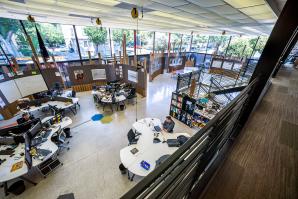When your business outgrows its current location, the prospect of moving can be a huge challenge. It’s essential to plan ahead to minimize lost hours. It won’t be easy, but if you follow the steps below, you can save yourself and your team a ton of frustration.
No. 1 pro tip: Create a committee for the moving process who can handle all of the details. These are the people who will handle communications with your real estate agent, coordinate in-house with department leads and ensure the whole process goes as smoothly as possible.
Three months pre-move: This is the time to make big decisions and alert your team about what to expect. If at all possible, attempt to move over a weekend or take two days midweek for the transition.
Accept that your daily work is going to be impacted, but know it’ll be worth it when you’re settled into your new space.
- Pick a moving company. The ideal fit is one that is nearby and provides boxes.
- Start a master document of all the invoices, clients and agencies that send physical mail. You’ll need to update them on your new address.
- The less you move, the easier it will be. Give clear guidelines to employees for reducing the amount of paperwork and stuff that needs to be moved.
- Contact your utility providers and get information on how to close out your existing accounts and set up new ones. Add these dates to your moving calendar.
- Design a simple “We’ve moved!” postcard that can be printed and shipped closer to the move date. If you need signage for your old or new location, get quotes now and find out how long it’ll take to ship.
- Decide if you’re going to host an open house following the move. Schedule it for one month after your move, so you have a little time to settle in.
Six weeks pre-move: Even if it feels like you have plenty of time, you probably have 50 percent more stuff than you thought, including inventory, files and computer cords. Time to downsize!
- Decide which furniture and equipment are coming with you. Give each piece a tag that says “stay” or “go.” If you’re not sure where all of the “go” tags are going, it’s time for a moving sale. Start making plans to hold one about two weeks prior to your move.
- If new furniture is in order, alert your employees of their budget and give a deadline two weeks prior to the move for selecting the new furniture.
- Block off your move dates so you’re not balancing clients, calls and movers all at the same time. Designate a few employees who will be answering phones and handling requests during the move.
- Plan any painting or upgrades to things like lighting and flooring, so they can be completed the week before move in. If you ordered signage, now is the time to start planning its installation.
- Order new business cards and marketing materials with your updated contact information.
Two weeks pre-move: If you already have the keys, then you’re in a great position to finalize any improvements, get the lights on and start moving the nonessentials, from old files to artwork.
- Start getting rid of the big items that won’t be coming with you. While this may mean you’re working with less surface area for a couple of weeks, it will help you strategize how to transport the items you’re saving. If you planned a moving sale, it should happen around this time.
- Allow employees to begin boxing up their offices. Be prepared with plenty of boxes, tape and markers. Ask employees to keep their boxes in their offices to keep hallways clear. Everything, including furniture, should be clearly marked with the employee’s name, department and new room number if possible.
- Create your technology plan to make sure every computer, printer and cord is accounted for. Use colored tape for hard-to-label items like cords.
- Remind employees of what’s expected during the day of the move and anything they’ll be required to transport on their own. Include moving-day dress code and start time.
- File your change of address form at the post office and begin notifying vendors and clients of your new location.
- Make sure the utilities — including internet — are up and running in the new space, so you’re ready to work right after the move.
Moving day: I hope you’re wearing comfortable shoes!
- Set up your phones and an email autoresponder right away. Don’t even try to keep up with messages today.
- Bring breakfast and coffee for the movers and employees — trust me, you’ll need it.
- Have a stock of small boxes or bags for found objects that don’t make it into a packed box. Use tape to label where the item came from in the old office.
- If you have a large office or many people coming in and out, assign someone to the front door as quality control. The last thing you need is a stranger walking off with a computer because you thought they worked for the moving company.
- Have a plan for furniture transport and assembly, especially if you’ve purchased new desks and chairs. If this will take several days, schedule it over a weekend so employees aren’t working from the floor.
Whew! We’re done, right? Well, not just yet. In the week following your move, there are some things to be completed before you’re completely settled in.
- Continue to update people and agencies of your new address. If you can, get friendly with the management company or new tenants of your old space, and check in for packages every few days for the first week after you move.
- Send out the bulk of those “We’ve moved!” postcards.
- Update your website with your new contact information.
- Keep some tools around for assembling odd furniture, hanging pictures and cleaning the new space.
- Send out an email to all employees detailing who to speak with if they need a trash can, something broke during the move, their printer is suddenly on the fritz, etc.
- Designate a central location in the new office where boxes and packing materials can be dropped off as employees unpack.
- Celebrate your successful move with coffee at the office or an informal happy hour to show your appreciation!
Moving is rarely fun. But when you begin with a plan in mind, the entire process can be much easier to manage.
Recommended For You

9 Ways to Sweeten Your Lease Terms
Budgets are finite—Spend smart to maximize your outcomes
Whether you’re looking for tenants or shopping for space: Here are some tips that might sweeten the deal or — if overlooked — can make one go sour.

Wide-Open Spaces
Banish the cubicles and fake ferns—Creative workers want customizable, collaborative workspaces
The old-school office style emphasized privacy and individual productivity. But the new model prioritizes the ideals of the creative class — that fast-growing, highly educated, well-paid segment of the workforce that values creativity, collaboration and the ability to customize.

Creative Spacing
4 factors to consider
VSP wanted The Shop in Midtown to be flexible, buildable and breakable, a learning space and a prototype in itself (form following function). With that in mind, architects put wheels on the tables and on corrugated cardboard walls to make everything portable and adaptable.

Commercial Lending Forecast
Softening standards with a chance of loans
This year could provide some of the first expansions in bank lending since 2008. So is the market back up to speed? No. But banks are slowly and smartly increasing their appetites for commercial lending, and the Capital Region will see its share of transactions.








